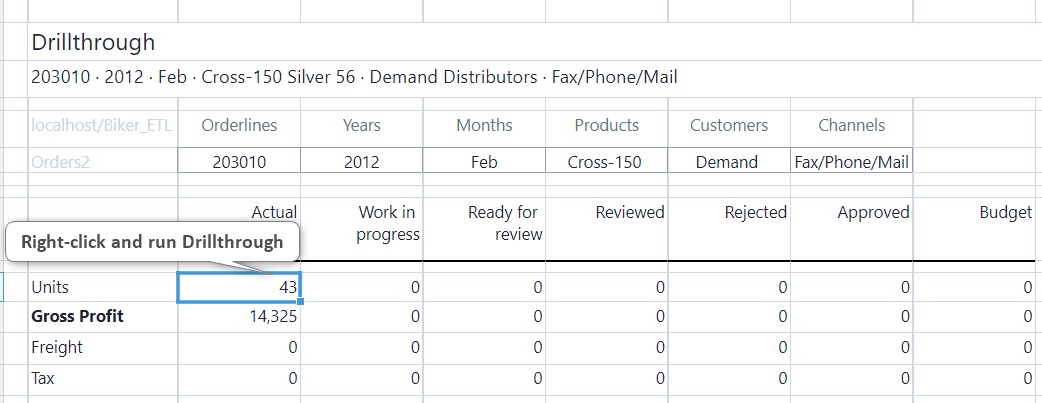See also Supervision Server (SVS)
Drilldown: expenditure of a consolidated figure along the hierarchy definition to see additional details of the subsequent level (the children of the consolidated element). The opposite of this term is "Roll up".
Drillthrough: expenditure of a figure by querying another data source providing more details than the initially used data source.
The required files for both processes contain the phrase "drill through" in their names. Therefore, you cannot deduce the running process from the file name. The same applies to the context menu command "drill-through".
Drilldown and drillthrough functionality both fetch and process potentially large datasets, which raise the RAM usage of the Supervision Server process. The amount of RAM which Supervision Server is allowed to consume is limited to prevent exhaustion of the system's resources. It is recommended practice to have size limitations in drillthrough scripts and prevent fetching of data if these size limits are surpassed. If necessary, the memory limit of the Supervision Server can be increased by contacting Jedox Support.
Note that if the SVS reaches the memory limit, this will cause a fatal error. The execution of the script is then interrupted. Fatal errors in the PHP interpreter used by SVS are unrecoverable and the OLAP Server will shut down.
Jedox drillthrough capabilities are a native functionality outside of the SVS scripts and do not require maintenance after a Jedox upgrade. This configuration offers five different modes and can only be managed by Jedox Support:
- drilldown: drills down to the cube base level, displaying the base values whose sum equals the value of the consolidated drillthrough cell. First and foremost, the rule-calculated values will be displayed. Only if there is no rule for a base cell will its stored value be displayed instead. If there is a rule calculation directly on the consolidated cell, only the value of the consolidated cell will be displayed. Note that this mode description is only available in versions 24.2 and later. The mode type (drilldrown) in versions 24.1 and earlier has the functionality of the mode drilldown-base (see below).
- drilldown-base (available in versions 24.2 and later): drills down to the cube base level, displaying only the stored values and ignoring any rule-calculated values. The sum of these values may not necessarily equal the value of the consolidation if any rules are active. Note that the functionality of this mode type is called "drilldown" in versions 24.1 and earlier.
- integrator: drills through to reveal relational data from ETL.
- automatic: executes the integrator mode by default. If no integrator drillthrough is defined, the drilldown mode will be executed (for versions 24.1 and earlier it will execute the functionality of the mode drilldown-base). The integrator drillthrough-mode is defined for the entire cube, not for specific areas.
- custom: uses the same logic as older Jedox versions and performs a drillthrough according to the OnDrillThroughExt function, which is part of the SVS script. Note that we do not recommend this mode as it may require maintenance by the customer when upgrading the Jedox environment.
If enabled, the default drillthrough-mode for every environment is automatic.
The default upper maximum for returned rows defined in the automatic or integrator mode is 1000 rows. The default timeout for a drillthrough request is 60 s (the default socket timeout in PHP).
To perform drillthrough a user must have at least R rights on a specific cell. For more information about user rights, see Rights Objects in Jedox.
Example
Start Jedox Web and open the Integrator. Navigate to Integrator Samples and select the sampleDrillthrough project. Before you can start sampleDrillthrough, you must run the sampleBiker jobs "Initdata" and "default" (in this order) to create the necessary dimensions.
Next, execute the job DrillthroughPersist for the newly loaded project. This job will create the new Jedox database Biker_ETL with the cube Orders2. The cube Orders2 has drilldown functionality.
Afterwards, create a Jedox View to preview the data of the newly created cube Orders2 from the Biker_ETL database.
Then, right-click on the shown cell and select “Drillthrough” from the context menu. A new popup window will open, displaying the detailed source data for the cell you have selected.
It is worth mentioning that the example importBikerDrillthrough only covers a certain slice of the cube Biker_ETL; not all cells in this cube will have drilldown data.
Note that the sample drillthrough scripts for the Supervision Server have been adapted to support usage of Virtual Dimensions; therefore, custom scripts for drillthrough may require adjustment.
Updated October 14, 2025

